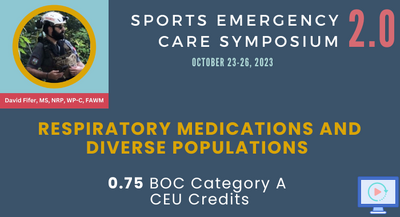Course Info (BOC Domains of Athletic Training; Presentation Description; Learning Objectives; Clinical Practice Gap Statement; Clinical Bottom Line; Summary Conclusions)
BOC Domains of Athletic Training:
-
Domain II - Clinical Evaluation and Diagnosis
-
Domain Ill - Critical Incident Management
- Domain IV - Therapeutic Interventions
Presentation Description:
In this presentation, we focus on respiratory medications and their application in diverse populations. You'll learn about the use and administration of bronchodilators, including the vital role athletic trainers play in assisting athletes with self-administration. We'll also differentiate between appropriate beta 2 agonists for athletic trainers and respiratory medications that are not suitable for emergencies. Additionally, we'll highlight the unique considerations when assessing and managing pediatric and geriatric patients with respiratory emergencies, ensuring you're well-prepared to handle these situations effectively.
Learning Objectives:
- Discuss the application or assistance in self-administration of bronchodilators.
- Differentiate between appropriate beta 2 agonists for use by Athletic Trainers and respiratory medications unsuitable for emergencies.
- Highlight unique considerations when assessing and managing pediatric and geriatric patients with respiratory emergencies.
Clinical Practice Gap Statement:
While athletic trainers frequently assist athletes with administering respiratory medications, there's a prevalent gap in understanding which medications are best suited for emergency scenarios. This knowledge deficiency is not merely limited to medication types but extends to handling respiratory emergencies in age-diverse populations like pediatrics and geriatrics. The ability to bridge these gaps is critical for offering comprehensive and effective care to athletes across all age groups.
Clinical Bottom Line Statement:
Understanding the role and application of respiratory medications in emergency situations is pivotal for athletic trainers. This presentation aspires to fill existing knowledge voids by educating trainers on the judicious selection of medications suitable for emergencies and underscoring the specific requirements of pediatric and geriatric athletes. Through this knowledge, athletic trainers will be more capable of making prompt, informed decisions that can significantly impact the outcomes for athletes in respiratory distress.
Summary Conclusion Statements:
- Mastery of respiratory medication application is fundamental for ensuring effective emergency response.
- Discerning between medications that are appropriate for emergency situations elevates the standard of athlete care.
- Being mindful of the unique healthcare requirements of pediatric and geriatric populations enhances the comprehensiveness of care provided.


